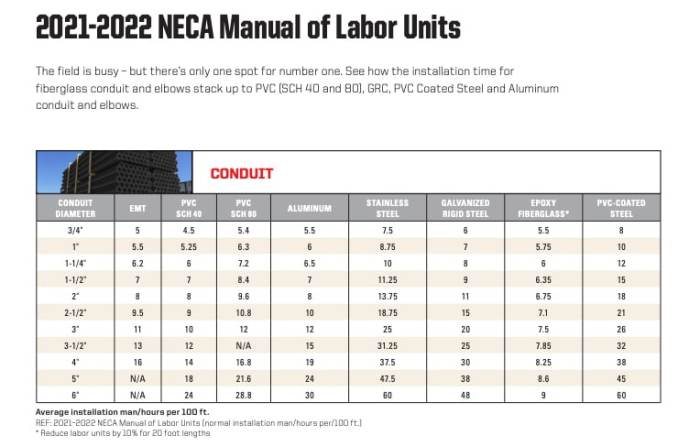The NECA Manual of Labor Units is the definitive guide for estimating labor costs in electrical construction. Developed by the National Electrical Contractors Association (NECA), this manual provides a comprehensive and standardized system for calculating labor units, ensuring accurate and consistent project estimates.
Throughout this exploration, we will delve into the intricacies of the NECA Manual of Labor Units, unraveling its structure, applications, and limitations. Prepare to gain a thorough understanding of this essential tool and its role in streamlining electrical construction projects.
Introduction to NECA Manual of Labor Units
The NECA Manual of Labor Units (MLU) is an indispensable resource for the electrical construction industry, providing standardized labor unit values for various electrical tasks and materials.
Developed by the National Electrical Contractors Association (NECA), the MLU has evolved over several decades to become the industry benchmark for labor productivity and estimating.
Intended Audience and Applications
The MLU is primarily intended for electrical contractors, estimators, project managers, and other professionals involved in the planning, bidding, and execution of electrical construction projects.
Its applications include:
- Estimating labor costs for electrical installations
- Comparing labor productivity across different projects and contractors
- Establishing labor budgets and project schedules
- Identifying areas for labor efficiency improvements
Structure and Organization of the Manual: Neca Manual Of Labor Units

The NECA Manual of Labor Units is meticulously structured to provide a comprehensive and user-friendly reference guide. The manual is divided into several sections and chapters, each dedicated to specific aspects of electrical construction.
The NECA Manual of Labor Units is an invaluable resource for electricians, providing detailed information on labor costs and productivity. Incidentally, the word “tomy” has a unique sound that is found in a variety of words, such as anatomy , botany, and zootomy.
Returning to the NECA Manual of Labor Units, its comprehensive data can help contractors accurately estimate labor costs and improve project efficiency.
The key components of the manual are summarized in the table below:
| Section | Description |
|---|---|
| Introduction | Provides an overview of the manual, its purpose, and how to use it effectively. |
| Section 1: General Information | Includes tables, formulas, and other general information relevant to electrical construction. |
| Section 2: Labor Units | Contains the core data of the manual, with labor units for a wide range of electrical construction tasks. |
| Section 3: Labor Factors | Provides factors that can be applied to labor units to account for specific project conditions or requirements. |
| Section 4: Estimating Procedures | Artikels the steps involved in using the manual to estimate labor costs for electrical construction projects. |
| Section 5: Appendices | Includes additional reference materials, such as a glossary of terms and a list of abbreviations. |
Labor Unit Calculations
Labor units are a standardized method of measuring the amount of work required to complete a construction task. They are used to estimate the cost of labor for a project and to schedule the work.
Labor units are calculated by multiplying the number of hours required to complete a task by the labor rate. The labor rate is determined by the skill level of the worker and the prevailing wage rates in the area where the project is located.
Factors that Influence Labor Unit Calculations
- The type of task being performed
- The skill level of the worker
- The prevailing wage rates in the area
- The efficiency of the worker
- The availability of materials and equipment
Examples of How Labor Units Are Used in Electrical Construction Projects
- To estimate the cost of labor for a project
- To schedule the work
- To track the progress of the work
- To compare the performance of different contractors
Applications in Electrical Construction

The NECA Manual of Labor Units is a comprehensive resource for electrical contractors, providing valuable insights and guidance for various aspects of project execution. It serves as a standardized reference point for estimating labor costs, scheduling work, and managing resources effectively.
Project Cost Estimation, Neca manual of labor units
The manual provides detailed labor unit values for a wide range of electrical tasks, enabling contractors to accurately estimate the labor costs associated with each project. By referencing the manual’s unit values, contractors can avoid underestimating or overestimating labor costs, ensuring competitive bids and profitable project outcomes.
Work Scheduling
The manual also assists contractors in developing realistic work schedules. The labor unit values indicate the average time required to complete specific tasks, allowing contractors to allocate resources efficiently and optimize project timelines. This ensures timely project completion, minimizes delays, and enhances overall project efficiency.
Resource Management
The NECA Manual of Labor Units plays a crucial role in resource management for electrical contractors. By accurately estimating labor requirements, contractors can determine the appropriate number of workers needed for each task and allocate resources accordingly. This helps avoid overstaffing or understaffing, optimizes labor utilization, and reduces project costs.
Case Studies
Numerous case studies demonstrate the successful application of the NECA Manual of Labor Units in the field. For instance, a major electrical contractor used the manual to estimate labor costs for a large-scale commercial project. By utilizing the manual’s unit values, the contractor was able to provide an accurate bid, secure the project, and complete the work within the estimated budget and timeline.
Limitations and Considerations

The NECA Manual of Labor Units, while a valuable tool, has limitations and requires careful consideration during use.
It is crucial to recognize that the manual provides average labor unit values based on historical data and industry practices. These values may not accurately reflect the specific circumstances or complexities of individual projects.
Interpreting and Applying Data Effectively
To effectively interpret and apply the data in the manual, consider the following guidelines:
- Use the manual in conjunction with other industry standards and best practices, such as the National Electrical Code (NEC) and the International Building Code (IBC), to ensure compliance and safety.
- Adjust labor unit values based on project-specific factors, such as job size, complexity, location, and labor availability.
- Consult with experienced electrical contractors and engineers to gain insights into the application of the manual and industry trends.
- Regularly review and update the manual to stay abreast of industry advancements and changes in labor practices.
Future Trends and Developments

The field of labor unit calculations is constantly evolving, driven by technological advancements and changing industry practices. The NECA Manual of Labor Units is expected to adapt to these trends, incorporating new technologies and reflecting the latest industry standards.
Technology and Innovation
- Artificial Intelligence (AI):AI-powered tools can automate labor unit calculations, reducing manual effort and improving accuracy. These tools can analyze historical data, identify patterns, and make predictions, leading to more efficient and data-driven decision-making.
- Virtual Reality (VR) and Augmented Reality (AR):VR and AR technologies can provide immersive experiences for training and planning purposes. They can simulate real-world construction scenarios, allowing users to visualize and practice tasks before performing them on-site, reducing potential errors and improving safety.
- Cloud Computing:Cloud-based platforms can store and share labor unit data, enabling collaboration and real-time updates. This allows multiple stakeholders to access and analyze data remotely, improving communication and coordination.
FAQ Guide
What is the purpose of the NECA Manual of Labor Units?
The NECA Manual of Labor Units provides a standardized system for calculating labor costs in electrical construction, ensuring accurate and consistent project estimates.
How are labor units calculated?
Labor units are calculated based on factors such as the type of electrical work, materials used, and labor rates. The manual provides detailed tables and formulas for calculating labor units for various tasks.
What are the benefits of using the NECA Manual of Labor Units?
The manual helps contractors estimate project costs accurately, schedule work efficiently, and manage resources effectively. It also promotes consistency and transparency in the electrical construction industry.